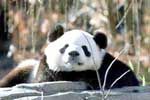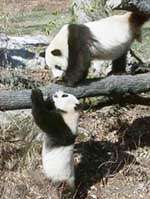 |
Chinese Pandas Make Debut at Washington National Zoo in US

Chinese Pandas Make Debut at Washington National Zoo in US
Chinese giant pandas Mei Xiang and Tian Tian made their debut at the Washington National Zoo in the United States Wednesday, a month after arriving from China in their new home.
"This is exciting," said National Zoo Director Lucy Spelman, as she introduced the pandas, who have been in quarantine since their arrival on December 6 last year.
"The pandas have done extremely well during quarantine. They essentially eat everything in sight, they are very people-oriented and very food-motivated," Spelman said.
She emphasized the pandas' ecological mission, saying that the zoo hoped the two would bolster support for preserving other endangered species.

Chinese Pandas Make Debut at Washington National Zoo in US
Minister of the Chinese Embassy in the United States Liu Xiaoming said that "they are two VIPs -- Very Important Pandas -- who have brought our two great nations closer together once again."
Chen Jianwei, deputy director of the Department of Wild Fauna and Flora Conservation of the State Forestry Administration of China, said the pair opened a new chapter in relations between the two countries.
The pandas' debut was recorded live on all the major networks in the United States, and the Washington Post had an eight-page supplement on the pandas Wednesday, providing a detailed map of their enclosure and copious minutiae on their diet and habits.
Using banner headline graphics such as "pandamonium" and "pandamania," television presenters gave hourly updates on the progress of the cuddly bears, who were visited last week by President Bill Clinton and his family.
Tian Tian is a three-and-a-half year old male whose name means "more and more," while Mei Xiang is a two-and-a-half year old female whose name means "beautiful fragrance."
The zoo has spent US$8 million for the reconstruction of the pandas house and a 10-person team is responsible for the pandas' daily lives.
The two joined five others of their species in the United States, three at the San Diego Zoo and two at the Atlanta Zoo.
The pandas, both born at the Wolong Giant Panda Reserve, are on loan to the Washington National Zoo for scientific research purposes in accordance with an agreement reached between the China Wildlife Conservation Association and the US zoo.
Chinese and American scientists are working together to develop an international breeding program to protect the endangered pandas, and the arrival of the two cubs, part of the program, is aimed to provide research opportunities for US zoologists.
In 1972, China sent two pandas to the Washington National Zoo, a gift from the Chinese government following President Nixon's visit to China that year. Ling-Ling died of heart failure in 1992 at the age of 23, while Hsing-Hsing died of kidney disease in 1999, aged 28.
Ling-Ling and Hsing-Hsing produced five offspring, but none lived longer than four days.
There are only about 1,000 pandas in the world now, most of them living in the mountains of the Sichuan Basin. The Wolong Reserve is a major habitat of the endangered species.

In This Section

|